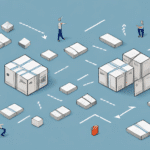Understanding the Difference Between a Fulfillment Center and a Distribution Center
In the world of e-commerce and supply chain management, fulfillment centers and distribution centers play crucial roles in ensuring that products reach their intended destinations. While these two types of facilities are often used interchangeably, they serve distinct functions. This article explores the key differences between fulfillment centers and distribution centers, their operational processes, the benefits they offer to businesses, and how technology is transforming these centers. Additionally, we will discuss future industry trends and factors to consider when outsourcing your fulfillment or distribution services.
The Role of Fulfillment Centers in the E-Commerce Industry
Fulfillment centers specialize in receiving, processing, and shipping customer orders for online retailers. Essentially, they are warehouses that store products until a customer places an order. Once an order is received, workers in the fulfillment center pick the items from inventory, package them, and ship them directly to the customer, a process known as order fulfillment.
One of the main advantages of using a fulfillment center for e-commerce businesses is the ability to scale operations quickly. As the business grows and the number of orders increases, the fulfillment center can handle the additional volume without the need for the business to invest in additional warehouse space or hire more staff. This scalability allows businesses to focus on other growth areas, such as marketing and product development.
Additionally, fulfillment centers enable faster and more reliable shipping to customers. Strategically located in areas that facilitate quick and efficient shipping across the country or internationally, fulfillment centers help improve customer satisfaction and increase repeat business. According to a study by ShipScience, businesses that utilize fulfillment centers experience a 20% increase in customer satisfaction due to faster delivery times.
The Role of Distribution Centers in Supply Chain Management
Distribution centers are integral to the supply chain management process, serving as hubs for receiving, storing, and shipping goods for multiple retailers or vendors. They collaborate with manufacturers and wholesalers to move products to retail locations, other distribution centers, or directly to customers. Typically larger and handling higher volumes of products than fulfillment centers, distribution centers optimize the flow of goods across the supply chain.
A key advantage of distribution centers is their ability to consolidate shipments from multiple suppliers. This consolidation reduces transportation costs and improves efficiency by allowing retailers to receive various products from different sources in a single delivery. Advanced inventory management systems in distribution centers enable real-time tracking of products, ensuring accurate information about product availability and delivery times.
Furthermore, distribution centers play a vital role in managing returns and reverse logistics. They inspect, sort, and process returned products for resale or disposal, helping retailers minimize losses and maintain customer satisfaction. Distribution centers also handle the disposal of hazardous or environmentally sensitive materials, ensuring compliance with regulations.
Key Differences Between Fulfillment and Distribution Centers
The primary difference between fulfillment and distribution centers lies in their purpose. Fulfillment centers focus on the final stage of the delivery process, handling individual customer orders. In contrast, distribution centers are concerned with the storage and movement of products throughout the entire supply chain, often serving multiple retailers or vendors.
- Volume of Products: Fulfillment centers handle smaller volumes of products tailored to individual orders, while distribution centers manage larger volumes, servicing multiple clients.
- Automation: Fulfillment centers typically employ advanced technologies like robots and automated conveyors to expedite order processing. Distribution centers may use automation to a lesser extent, emphasizing storage and transportation.
- Location: Fulfillment centers are usually situated closer to urban areas and major population centers to ensure quick delivery times. Distribution centers are often located in more remote areas with easy access to transportation infrastructure such as highways and railroads.
Size and Capacity of Fulfillment vs. Distribution Centers
Fulfillment centers are generally smaller than distribution centers, as they carry inventory for a single retailer or vendor and focus on individual customer orders. Despite their smaller size, fulfillment centers are strategically located near urban areas to facilitate faster delivery times.
In contrast, distribution centers are larger and have higher storage and handling capacities, accommodating inventory for multiple retailers or vendors. They are typically located in areas with lower real estate costs and excellent transportation links to efficiently manage bulk shipments.
Operational Processes in Fulfillment Centers
Fulfillment centers engage in several key operational processes, including:
- Receiving and Processing Inventory: Inventory is received, checked for accuracy, and stored until orders are placed.
- Inventory Management: Advanced systems track inventory levels in real-time to ensure accurate order fulfillment.
- Picking and Packing: Items are selected from inventory, packaged securely, and prepared for shipping.
- Shipping: Orders are shipped directly to customers using various delivery carriers.
To streamline these processes, fulfillment centers often utilize technologies such as automated storage and retrieval systems, conveyors, and sorting machines. Many fulfillment centers also offer additional services like kitting and assembly, returns management, and packaging customization.
Quality control is another critical aspect of fulfillment center operations. Products undergo inspections to ensure they meet required standards before shipping to customers. This includes visual inspections, functional testing, and packaging checks. Fulfillment centers may also employ specialized teams or equipment to handle fragile or hazardous products, and implement security measures such as surveillance cameras and access control systems to prevent theft or damage.
Operational Processes in Distribution Centers
Distribution centers manage a variety of operational processes, including:
- Receiving and Unloading Shipments: Incoming shipments are received, checked for accuracy, and unloaded for storage.
- Inventory Management: Advanced warehouse management software tracks inventory levels and locations in real-time.
- Order Picking and Packing: Orders for multiple retailers or vendors are picked and packed for distribution.
- Shipping: Products are shipped to their final destinations using optimized transportation methods.
In addition to these core processes, distribution centers handle returns and address any issues that arise with orders. This involves inspecting returned products, determining if they can be resold or must be disposed of, and processing refunds or exchanges for customers. Distribution centers must also be prepared to handle unexpected events like product recalls or weather-related disruptions, ensuring quick and effective responses to minimize negative impacts.
Safety is paramount in distribution centers due to the presence of heavy machinery and large volumes of products. Strict safety protocols, including training programs, safety equipment, and regular inspections, are implemented to protect workers and ensure compliance with regulations.
Benefits of Using a Fulfillment Center for Your Business
Utilizing a fulfillment center offers numerous benefits, including:
- Streamlined Order Fulfillment: Faster and more efficient processing and shipping of orders.
- Advanced Technology: Enhanced accuracy in picking and packing orders, reducing errors and improving customer satisfaction.
- Cost Reduction: Lower overhead costs by eliminating the need for your own storage and shipping facilities.
- Scalability: Easily scale operations to accommodate business growth without significant investments.
Benefits of Using a Distribution Center for Your Business
Engaging a distribution center provides several advantages, such as:
- Increased Storage Capacity: Access to larger storage facilities to accommodate growing inventory.
- Efficient Shipping Processes: Streamlined supply chain operations leading to faster and more reliable shipments.
- Cost Savings: Centralized storage can lead to volume discounts on shipping and logistics.
- Improved Supply Chain Management: Enhanced coordination and real-time tracking of products throughout the supply chain.
Choosing the Right Center for Your Business Needs
When deciding between a fulfillment center and a distribution center, it's essential to assess your specific business needs:
- If you're primarily an online retailer: A fulfillment center is likely the better option, focusing on individual customer orders and faster delivery times.
- If you're a manufacturer or wholesaler: A distribution center may be more suitable, facilitating the movement of products throughout the supply chain efficiently.
Consider factors such as order volume, inventory management needs, desired delivery speed, and cost when making your decision.
How Technology is Transforming Fulfillment and Distribution Centers
Technology is revolutionizing fulfillment and distribution centers by introducing automation, robotics, and artificial intelligence to streamline operations and enhance efficiency. Key technological advancements include:
- Automation: Automated storage and retrieval systems, conveyors, and sorting machines accelerate the order processing cycle.
- Robotics: Robots assist in picking, packing, and moving products, reducing manual labor and increasing accuracy.
- Artificial Intelligence: AI-powered systems optimize inventory management, predict demand, and enhance decision-making processes.
These technologies improve accuracy, speed up order processing, and reduce costs associated with manual labor, enabling centers to handle larger volumes more efficiently.
Future Trends in the Fulfillment and Distribution Industry
The future of fulfillment and distribution centers is shaped by innovative solutions addressing challenges such as increasing delivery speeds and sustainable operations. Emerging trends include:
- Same-Day Delivery: Growing consumer demand for faster delivery times is driving centers to optimize their operations for same-day or next-day deliveries.
- Automation and Robotics: Continued investment in automation and robotics to enhance efficiency and reduce reliance on manual labor.
- Sustainable Practices: Implementation of eco-friendly practices, such as energy-efficient lighting and packaging materials, to minimize environmental impact.
- Blockchain Technology: Use of blockchain for improved transparency and traceability in the supply chain.
As technology advances and consumer expectations evolve, fulfillment and distribution centers will continue to enhance their operations to meet the demands of an ever-changing marketplace.
Examples of Successful Companies that Use Fulfillment or Distribution Centers
Many leading companies rely on fulfillment and distribution centers to deliver products to customers efficiently. Notable examples include:
- Amazon: Utilizes a vast network of fulfillment centers worldwide to ensure timely delivery of millions of products.
- Walmart: Operates state-of-the-art distribution centers to manage its extensive global supply chain effectively.
- FedEx and UPS: Offer comprehensive fulfillment and distribution services to businesses of all sizes, facilitating efficient shipping and inventory management.
Cost Comparison: In-House vs. Outsourced Fulfillment and Distribution Services
When choosing between in-house and outsourced fulfillment or distribution services, it's important to evaluate the associated costs:
- In-House Facilities: Offer greater control over the supply chain but require significant upfront investments in infrastructure, equipment, and personnel.
- Outsourced Services: Provide cost savings by eliminating the need for capital investments and reducing overhead expenses. Outsourcing also offers flexibility to scale operations based on demand.
According to a report by ShipScience, businesses that outsource their fulfillment services can reduce operational costs by up to 30%, while also benefiting from the expertise and technology of third-party providers.
Factors to Consider When Outsourcing Your Fulfillment or Distribution Services
If you decide to outsource your fulfillment or distribution services, consider the following factors when selecting a provider:
- Reputation and Experience: Choose a provider with a proven track record and extensive experience in your industry.
- Location: Ensure the provider's facilities are strategically located to optimize shipping times and costs.
- Capacity and Scalability: Assess whether the provider can handle your current volume and accommodate future growth.
- Technology Infrastructure: Evaluate the provider's technology systems for inventory management, order processing, and real-time tracking.
- Customer Service: Ensure the provider offers reliable customer support and can effectively manage peak demand periods.
Thoroughly vetting potential providers based on these criteria will help ensure a successful partnership that meets your business needs.
Conclusion
Understanding the differences between fulfillment and distribution centers is essential for making informed decisions about your business's supply chain management. Fulfillment centers and distribution centers each offer unique benefits tailored to specific operational needs. The right choice depends on your business model, order volume, inventory management requirements, and growth plans. As technology continues to advance, these centers will become even more efficient and innovative, helping businesses adapt to the evolving demands of the marketplace.






















